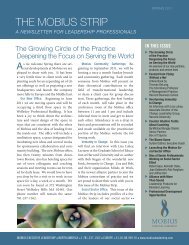Leadership & Mindfulness - Mobius Executive Leadership
Leadership & Mindfulness - Mobius Executive Leadership
Leadership & Mindfulness - Mobius Executive Leadership
Create successful ePaper yourself
Turn your PDF publications into a flip-book with our unique Google optimized e-Paper software.
LEADERSHIP & <strong>Mindfulness</strong>all sentient beings, or the whole universe?• How big are your spheres of control,influence, and concern respectively?• To what extent do you see yourself aspart of a larger whole, as dependentupon a larger, interconnected system?Reflection questions during facilitation• What stakeholders could you talk towithin the system to get a wider perspectiveof the system or for strongercollaboration and ownership amongstakeholders?• What patterns exist within the systemthat you can recognise?• What is not being talked about withinthe system?• What questions need to be asked tohelp those within the system senseand see the system more completely?• What experience does the systemneed to sense, in order to see itself?(See co-sensing, Theory U).Practices for developingWhole System AwarenessBody Whole System-Awareness. Noticeyourself being aware of your own bodyas a whole system: all of your organs,your digestive system, and circulatorysystem are interconnected. Your bodycannot function optimally if the one partof the system is not operating optimally.Now connect this concept to everythingelse (relationships, your home, theenvironment etc.). Ask yourself reflectivequestions: what is not whole in myphysical body, my relationships, myworkplace? If I work to improve thatarea, how will it affect the whole system?A thought exercise. “What happensto one breath of air?” by astronomerHarlow Shapley: (http://bit.ly/j9ve8N)demonstrating the gas argon in the airwe all breathe is the same breath ofargon used by Jesus Christ, Joan of Arcand Mahatma Gandhi, for example. Weliterally all breathe the same air, and itcycles through us from all past generationsto all future generations. Thisdemonstrates the interconnections existingbetween everyone, as well as thelaws of thermodynamics stating thatmatter within our biosphere does notdisappear and all matter spreads.Whole System Awareness: Resources forfurther exploring, practice, and reading• Booth Sweeney, L. & D. Meadows.2008. The Systems Thinking Playbook.• Capra, F. 1997. The Web of Life. ANew Scientific Understanding of LivingSystems.• Meadows, D. 2008. Thinking in Systems:A Primer.• Senge, P. 1990. The Fifth Discipline.The Art & Practice of the LearningOrganization.• Scharmer, O. Theory U, material onco-sensing: http://bit.ly/o60g41.• Wheatley, Margaret, J. 2006. <strong>Leadership</strong>and the New Science: DiscoveringOrder in a Chaotic World.Whole Self-AwarenessWhat is it? Whole Self-Awareness is thecontinual, lifelong process of paying attentionto knowing one’s self; it involvesconsciously and intentionally observingvarious dimensions of the self (includingthe physical, mental, shadow, emotionaland spiritual realms). It is the capacityto observe how one is thinking, relating,feeling, sensing, and judging. Whole Self-Awareness includes perceptions beyondthe rational mind, such as intuition.Principles: Pay attention to all thedimensions of yourself (physical, emotional,spiritual, shadow and mentaldimensions). Your body is not a transporterfor your head, you are a wholesystem.Self-reflection questions• How would others describe you?What do you tell yourself aboutyourself?• Think of someone you admire, whatdo you admire about them? Whatdoes this tell you about your values?What can you learn about yourselffrom this admiration?• Think of someone that irritates you,why do they irritate you? What doesthis tell you about your values? Whatcan you learn about yourself fromthis irritation?• When something is physically challengingto you, how do you respond?• Are you aware of how you are feelingthroughout the day?• What emotions are acceptable, whatemotions are not acceptable?• How do you feel physically, emotional,spiritually, energetically andmentally right now?Reflection questions during facilitation• What reactions are you having withthis group that need to be exploredor shared now or later?• What do you perceive to be occurringwithin this group beyond yourcognition?• How can you invite the group to beengaged beyond cognition? How areyou inviting the mental, physical,emotional, and spiritual dimensionsof this group to participate?• Is your whole self (body, mind, spirit,emotion, and shadow) in alignment?Is your head agreeing to do somethingand another dimension ofyourself not in agreement?Practices for developing yourWhole Self-AwarenessConcentration meditation practice.These practices focus your thoughtson a particular object (such as thechakra system or visualising whitelight moving through the body) toshut out the outside world and preventthe mind from wandering. Forwww.mobiusleadership.com | <strong>Mobius</strong> <strong>Executive</strong> <strong>Leadership</strong> 71



